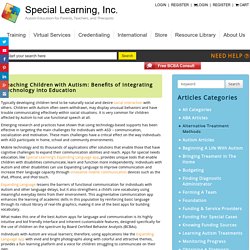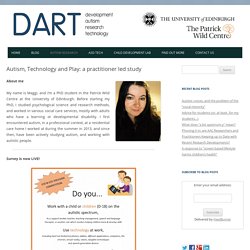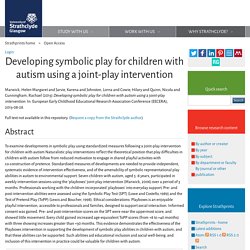

Page from SMART-ASD - University of Bath. Page from SMART-ASD - University of Bath. Page from SMART-ASD - University of Bath. Special Learning Articles. Teaching Children with Autism: Benefits of Integrating Technology. Typically developing children tend to be naturally social and desire social interaction with others.

Children with Autism often seem withdrawn, may display unusual behaviors and have trouble communicating effectively within social situations. It is very common for children affected by Autism to not use functional speech at all. Emerging research and practices have shown that using technology-based supports has been effective in targeting the main challenges for individuals with ASD – communication, socialization and motivation. These main challenges have a critical effect on the way individuals with ASD participate in home, school and community environments.
Mobile technology and its thousands of applications offer solutions that enable those that have cognitive challenges to expand their communication abilities and reach. Through the use of apps that teach children with Autism, language and communication are no longer remote possibilities for these children. Autism, Technology and Play: a practitioner led study.
About me My name is Maggi, and I’m a PhD student in the Patrick Wild Centre at the University of Edinburgh.

Before starting my PhD, I studied psychological science and research methods, and worked in various social care services, mostly with adults who have a learning or developmental disability. I first encountered autism, in a professional context, at a residential care home I worked at during the summer in 2013, and since then, have been actively studying autism, and working with autistic people. Survey is now LIVE! The Short Story: What I’m planning to do my PhD research on My project will focus on whether technology influences social behaviours in children with autism. The Long Story: Exploring social ‘spin-off’ benefits of technology in children with autism‘Technology’ is an integral part of our everyday lives – and is developing at an astonishingly fast rate.
A young child playing Pokemon Go. Contacting me. Developing symbolic play for children with autism using a joint-play intervention. Marwick, Helen Margaret and Jarvie, Karena and Johnston, Lorna and Cowie, Hilary and Quinn, Nicola and Cunningham, Rachael (2013) Developing symbolic play for children with autism using a joint-play intervention.

In: European Early Childhood Educational Research Association Conference (EECERA), 2013-08-28. Full text not available in this repository. (Request a copy from the Strathclyde author) To examine developments in symbolic play using standardized measures following a joint-play intervention for children with autism Naturalistic play interventions reflect the theoretical position that play difficulties in children with autism follow from reduced motivation to engage in shared playful activities with co-construction of pretence. Standardised measures of developments are needed to provide independent, systematic evidence of intervention effectiveness, and of the amenability of symbolic representational play abilities in autism to environmental support.
Bilingualism, Autism and Executive Functions. The impact of bilingualism on the executive control functions of children with autism spectrum disorder (ASD) Hello everyone!

My name is Shereen, I’m from Egypt, born and raised in the United Arab Emirates. In 2006, I started a journey of higher education. During this journey, I resided in several countries through which I acquired several multilingual and multicultural experiences. Along the way, I was introduced to a course named ‘The Psychology of Bilingualism’ which opened my eyes to the dearth of research investigating the impact of experiences like mine.
What do we already know? Speaking two lan guages has been shown to have a broad impact on human cognition, especially in the area of executive functions. While some studies debate the existence of any cognitive advantages for bilinguals, we can all agree that findings have been focused on typically developing population. Significance of this research : Consequences for Therapy, Education and Identity Keep in mind… Where are we now? Three Ways School Sensory Garden. Art in the Three Ways Sensory Studio. Art in the Three Ways Sensory Studio. Robots4Autism - An Error Occurred Setting Your User Cookie. The Picture Exchange Communication System (PECS) What is PECS?

The Picture Exchange Communication System, or PECS, allows people with little or no communication abilities to communicate using pictures. People using PECS are taught to approach another person and give them a picture of a desired item in exchange for that item. By doing so, the person is able to initiate communication. A child or adult with autism can use PECS to communicate a request, a thought, or anything that can reasonably be displayed or symbolized on a picture card. PECS works well in the home or in the classroom. PECS was developed in 1984 by Lori Frost, MS, CCC/SLP and Dr. At one time many people opposed the use of PECS and sign language to teach children with autism to communicate.
The Six Phases of the Picture Exchange Communication System Are: PECS PHASE I: How to Communicate The child with autism learns to exchange single pictures for items or activities they really want. Autism Apps.